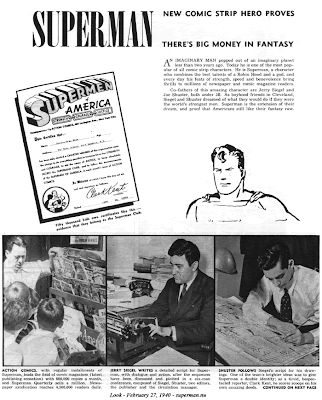BOOK REVIEW
How Superman Would End the War (1940)
This book review (magazine actually) is offered as part of Friday’s Forgotten Books meme over at Patti Abbott’s blog Pattinase. Hop over and check out the eclectic mix of reviews by other bloggers. It will be worth your while.
Jerry Siegel and Joe Shuster were bubbling with ideas to give Superman new adventures. How else do you explain this two-page comic story Jerry wrote and Joe drew for Look, a general-interest American magazine, in February 1940? The world is barely six months into World War 2 when the Man of Steel swoops down upon Hitler’s alpine mountain retreat and flies off with him, like a great eagle taking off with its unsuspecting prey.
Superman then stops over in Moscow to grab hold of Hitler’s ‘friend’ Josef Stalin, in front of his troops, before turning around and heading for Geneva where he deposits the two dictators at a meeting of the League of Nations which holds them “guilty of modern history’s greatest crime — unprovoked aggression against defenceless countries.” We don’t know whether they are sentenced to death or to a life behind bars. Death by legal or foul means was rare in early comics in which superheroes regularly handed over criminals to law enforcers.
Everything’s fine about this short comic story except for Superman’s costume — white bodysuit, white cape and a pair of red shorts. Even the big ‘S’ on his chest is wonky. Those were early days. I liked the comic though, it’s vintage stuff (courtesy: www.archive.org).
Take a look at the comic strips below…and don’t forget to check out an sf book way below.
The blurb on the back cover says...
When race survival teetered in the balance...
Captain Absolom Bracer, with an artificial brainpan and synthetic eyes. Astrogation officer Gene O'Gwynn, a lady with a plastic face. Weapons officer Akin Darby and Communications Officer Miss Cyanta, both with assorted prosthetic parts.
These were the officers of the Iwo Jima, one of the two heavy battle-cruiser starships protecting the vast, cumbersome Rudoph Cragstone, a hospital ship returning to Earth with thiousands of wounded in 'cold-sleep'. These brutally injured officers had been restored to temporary, artificial life to do this job because no intact man or woman could be spared from the main conflict.
But then Breakaway Station, a vital link with Earth, was suddenly threatened...
How Superman Would End the War (1940)
This book review (magazine actually) is offered as part of Friday’s Forgotten Books meme over at Patti Abbott’s blog Pattinase. Hop over and check out the eclectic mix of reviews by other bloggers. It will be worth your while.
Jerry Siegel and Joe Shuster were bubbling with ideas to give Superman new adventures. How else do you explain this two-page comic story Jerry wrote and Joe drew for Look, a general-interest American magazine, in February 1940? The world is barely six months into World War 2 when the Man of Steel swoops down upon Hitler’s alpine mountain retreat and flies off with him, like a great eagle taking off with its unsuspecting prey.
Superman then stops over in Moscow to grab hold of Hitler’s ‘friend’ Josef Stalin, in front of his troops, before turning around and heading for Geneva where he deposits the two dictators at a meeting of the League of Nations which holds them “guilty of modern history’s greatest crime — unprovoked aggression against defenceless countries.” We don’t know whether they are sentenced to death or to a life behind bars. Death by legal or foul means was rare in early comics in which superheroes regularly handed over criminals to law enforcers.
Everything’s fine about this short comic story except for Superman’s costume — white bodysuit, white cape and a pair of red shorts. Even the big ‘S’ on his chest is wonky. Those were early days. I liked the comic though, it’s vintage stuff (courtesy: www.archive.org).
Take a look at the comic strips below…and don’t forget to check out an sf book way below.
Among other Forgotten Books news (at my end), I recently picked up a used science fiction paperback titled We All Died at Breakaway Station by American sf writer Richard C. Meredith (Venture SF, 1969). A short version of this story, about “race survival teetering in the balance,” appeared in Amazing (1968). I liked the cover. I hope I like the story too.
The blurb on the back cover says...
When race survival teetered in the balance...
Captain Absolom Bracer, with an artificial brainpan and synthetic eyes. Astrogation officer Gene O'Gwynn, a lady with a plastic face. Weapons officer Akin Darby and Communications Officer Miss Cyanta, both with assorted prosthetic parts.
These were the officers of the Iwo Jima, one of the two heavy battle-cruiser starships protecting the vast, cumbersome Rudoph Cragstone, a hospital ship returning to Earth with thiousands of wounded in 'cold-sleep'. These brutally injured officers had been restored to temporary, artificial life to do this job because no intact man or woman could be spared from the main conflict.
But then Breakaway Station, a vital link with Earth, was suddenly threatened...
It looks like a challenging read, doesn't it?




































